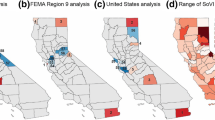Abstract
This article presents a multiple regression analysis of demographic and social data for 335 wards in 17 American cities in 1890. The most important findings are: (1) Density effects on mortality were uniformly positive and statistically significant; the magnitude of these effects was much greater for child mortality than for adult mortality; and child mortality was more sensitive to persons per dwelling than to persons per acre. (2) Unsanitary conditions, as measured by the city-specific typhoid fever death rate, significantly increased mortality and child mortality was much more sensitive in this respect than adult mortality. (3) Given the same age composition and population density, foreign-born whites, native-born whites, and the colored population had about the same adult death rate.
Similar content being viewed by others
References
Cohen, S., and Sherrod, D. R. (1978). When density matters: Environmental control as a determinant of crowding effects in laboratory and residential settings.Journal of Population 1: 189–202.
Condran, G., and Crimmins-Gardner, E. (1976). Mortality Differentials in the United States in the Nineteenth Century. Paper presented to the American Sociological Association Meeting at New York.
Condran, G., and Crimmins-Gardner, E. (1978). Public health measures and mortality in U.S. cities in the late nineteenth century.Human Ecology 6(1): 27–54.
Easterlin, R. A. (1977). Population issues in American economic history: A survey and critique. In Gallman, R. E. (ed.),Recent Developments in the Study of Business and Economic History: Essays in Memory of Herman E. Krooss, JAI Press, Greenwich, Conn., pp. 131–158.
Fuertes, J. H. (1897).Water and Public Health: The Relative Purity of Waters from Different Sources. Wiley, New York.
Fuller, G. W. (1912).Sewage Disposal. McGraw-Hill, New York.
Galle, O. R., and Gove, W. R. (1978). Overcrowding, isolation, and human behavior: Exploring the extremes in population distribution. In Taeuber, K. E., Bumpass, L. L., and Sweet, J. A. (eds.),Social Demography, Academic Press, New York, pp. 95–132.
Grossman, M. (1972).The Demand for Health: A Theoretical and Empirical Investigation. National Bureau of Economic Research, New York.
Haines, M. R. (1977). Mortality in nineteenth-century America: Estimates from New York and Pennsylvania census data, 1865 and 1900.Demography 14: 311–331.
Higgs, R. (1973). Mortality in rural America, 1870–1920: Estimates and conjectures.Explorations in Economic History 10: 177–195.
Higgs, R. (1977).Competition and Coercion: Blacks in the American Economy, 1865–1914. Cambridge University Press, New York.
Hoffman, F. L. (1906). The general death rate of large American cities, 1871–1904.Quarterly Publications of the American Statistical Association 10: 1–75.
Kitagawa, E. M., and Hauser, P. M. (1973).Differential Mortality in the United States: A Study in Socioeconomic Epidemiology. Harvard University Press, Cambridge.
Meeker, E. (1972). The improving health of the United States, 1850–1915.Explorations in Economic History 9: 353–373.
Meeker, E. (1976). Mortality trends of southern blacks, 1850–1910: Some preliminary findings.Explorations in Economic History 13: 13–42.
Press, S. J. (1972).Applied Multivariate Analysis. Holt, Rinehart and Winston, New York.
Preston, S. H., and van de Walle, E. (1978). Urban French mortality in the nineteenth century.Population Studies 32: 275–297.
Rao, P., and Miller, R. L. (1971).Applied Econometrics. Wadsworth, Belmont, Calif.
Riis, J. A. (1890).How the Other Half Lives: Studies Among the Tenements of New York. Charles Scribner's Sons, New York.
Sedgwick, W. T., and MacNutt, J. S. (1910). On the Mills-Reincke phenomenon and Hazen's Theorem concerning the decrease in mortality from diseases other than typhoid fever following the purification of public water supplies.Journal of Infectious Diseases 7: 489–564.
Smith, S. (1911).The City That Was. Frank Allaben, New York.
U.S. Census Office (1896a).Report on Vital and Social Statistics in the United States at the Eleventh Census: 1890. Pt. I.Analysis and Rate Tables. U.S. Government Printing Office, Washington, D.C.
U.S. Census Office (1896b).Report on Vital and Social Statistics in the United States at the Eleventh Census: 1890. Pt. II.Vital Statistics. Cities of 100,000 Population and Upward. U.S. Government Printing Office, Washington, D.C.
Ward, D. (1969). The Internal Spatial Structure of Immigrant Residential Districts in the Late Nineteenth Century.Geographical Analysis 1: 337–353.
Ward, D. (1971).Cities and Immigrants: A Geography of Change in Nineteenth-Century America. Oxford University Press, New York.
Author information
Authors and Affiliations
Rights and permissions
About this article
Cite this article
Higgs, R., Booth, D. Mortality differentials within large American cities in 1890. Hum Ecol 7, 353–370 (1979). https://doi.org/10.1007/BF00888102
Issue Date:
DOI: https://doi.org/10.1007/BF00888102




